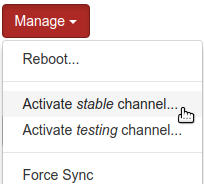The three different OS channels
We’re always working to improve info-beamer. All production devices use the stable channel of the operating system. This version is updated usually 2-3 times per year. If you want to try out new features right now you can always switch to a different channel. Besides the stable channel there’s two other channels. In total we operate three channels:
-
stable- This is the default channel if you download theinstall.zipfile from the dashboard. All production devices should run thestablechannel. It’s updated automatically from time to time. Follow the blog for release announcements. -
testing- This is going to be the nextstableversion eventually. This channel is pretty reliable but things might change and if you’re unlucky, some packages might stop working temporarily due to bugs. Don’t use this in production unless the screens are in walking distance and it’s ok if they might not work from time to time. -
bleeding- This is where all the new development happens. You can almost follow it live. Switching to this channel is only recommended for non-public development Pis that you use to develop packages.
How to switch
Switching between stable and testing is easy. On the device dashboard, click the Manage button and select either Activate stable channel or Activate testing channel:

The device will fetch the selected version, install it and then reboot the device. This might take a moment, so be patient. The bleeding channel is only installable through either the API or using the syncercmd command on the device itself. If you ssh into your device, run
$ syncercmd system switch_bleeding
This will install the bleeding version and reboot. You can always get back to either testing or stable using the dashboard or by running:
$ syncercmd system switch_stable
or
$ syncercmd system switch_testing